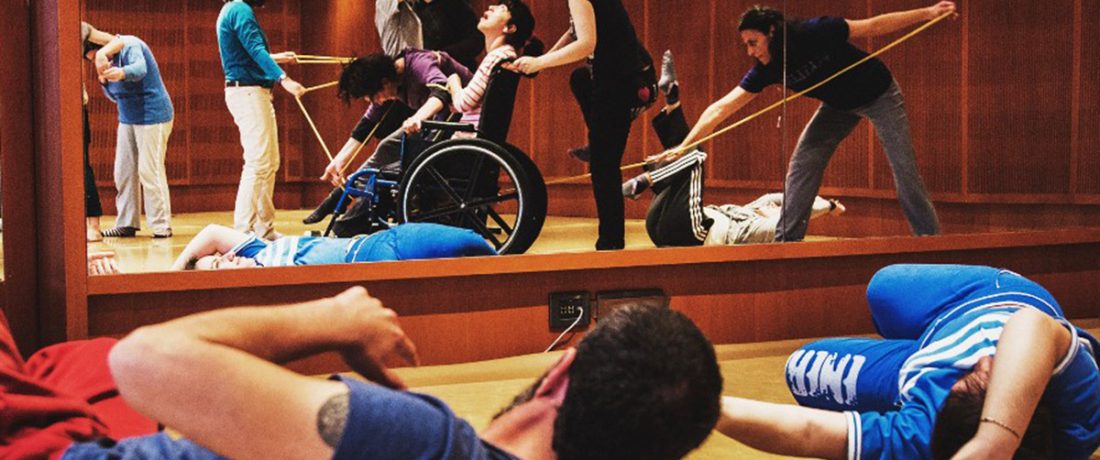
Fitness Class
TARGET GROUP
Adults with and without disabilitiesPARTICIPANTS
18-22DURATION
1.5 hoursORGANIZATION
Stopgap Dance CompanyGoal - Essential question
To explore different and effective ways to train the body using various forms of resistance.
Preparation
Download interval timer for Tabata style fitness section.
Be aware of your body and what your capabilities are. Whilst we recommend challenging yourselves, be careful not to overdo it. If you have not done similar fitness based work before, you should aim gradually to build up to this.
Short Repetitive Spine exercise (5 minutes)
Work through a simple repetitive exercise focusing on the spine and core, building in speed.
Example: Eight reaches up the side of the body, down through centre. Eight reaches up through the centre of the body down the side.
Eight spiraling reaches up on side and down through centre.
Eight reaches up through centre, spiraling down one side.
Repeat four times each, two times each, one time each,
Tip: Choose a song/track that lasts about 5 minutes and try to keep going for the length of the song.
Outcomes: Focusing on expanding the breath and bringing warmth and space into the spine.
Cardio Cycle (10-15 minutes)
Choose five different cardio movements, work through them in order keeping each one going for one minute. Repeat the full cycle two-three times as desired.
Progression: Increase the intensity (speed, range of movement etc.) each round, increase the number of rounds.
Outcome: Designed to raise the heart rate.
Travelling with resistance (15 minutes)
Travelling from one side of the room to the other, working in pairs, and changing partners regularly.
1. Without making contact with each other, one person tries to block the other person from getting to the other side of the space. Repeat with the roles switched over. To allow for different speed and maneuverability, if a standing dancer is working with a wheelchair user, they could move with four limbs on the ground.
2. Staying in contact but specifically without grabbing or holding the other person, one person tries to pass while the other tries to block. When the person trying to past gets in front of their partner, the roles switch and they become the blocker, with the other person trying to pass.
3. One person tries to resist the other moving to the other side of the room by either holding onto their hips, back bar of their wheelchair or any place that is comfortable for the person. Alternate version could be shoulder-to-shoulder resistance, play with many versions! Can be progressed by varying the resistance between yourself and your partner.
Outcome: To work on dexterity and agility, also using resistance within contact to build strength.
Balanced resistance with a partner (5/10 minutes)
Start side to side with a partner, facing opposite ways. The partners then join hands and use resistance to push the boundaries of balance by attempting to push their partner to work harder to retain their balance.
Progressions: Make balancing more of a challenge by starting in a less stable position, for example – being in a wheelchair, on tiptoes or on one leg. You could also try having three people involved.
Outcome: To work on balance and coordination of body.
Wrist preparation (2-3 minutes)
Holding your arms straight out in front of you, open the hands as wide as possible then clench them as tight as possible. Repeat 10/20/30 times as fast as possible. Repeat each set with the arms in a different position – out in front of you, above your head, out to your side, down by your sides. Give the wrists and hands a shake out and repeat as desired.
Progression: Increasing the repetitions and rounds.
Outcome: Very short preparation for taking weight.
Tabata style fitness workout (20-30 minutes)
Explanation time necessary to clarify form and safety within the exercises – this also gives a brief rest time. Using an interval timer if possible to time the workouts, (this will relieve the pressure of time keeping throughout the workout). Suggested structure: Eight sets of twenty- seconds with ten seconds rest in between, followed by twenty seconds then between each exercise. Example exercises below (though any strengthening exercises can be used, always with a consideration towards translations):
1. Weight transfers: Lunges in different directions, focusing on strength and dynamics in the legs, or reaching away from centre and putting weight into hand.
2. Rises and lowers: Rising onto the balls, either two feet or one. Or pushing up and down through arms onto side of wheelchair.
3. Side tilts: Starting upright, tilt the body from side to side to engage sides and core.
4. Balance and body crosses: Find a dynamic balance, e.g. plank position, wheelie. Reach limbs across the centre of your body.
Feel free to find the exercises that work best for you/your group. Everyone might have a different set of exercise to allow for different needs and levels. You can introduce weights or resistance bands to add more of a challenge.
An example of this can be found in the iDance Learning Corner, Digital Material under Fitness with Christian by Stopgap Dance Company.
Fun Fitness games | in pairs (10-15 minutes)
Target practice: In partners, one person finds a balance and the other offers targets. The person in balance must contact the targets as fast as possible and as many times as possible in a specified time limit.
Resisted partner exercises: In partners, one person finds an exercise such as a press up, sit up, chest fly and the other partner finds a way to resist and make this movement challenging for them.
Outcome: Fun, friendly competition.
Cooldown (5-10 minutes)
Gauge what the group needs to stretch and relax the body after the session.
